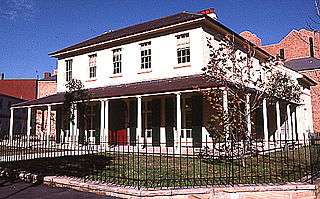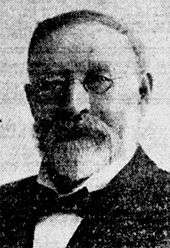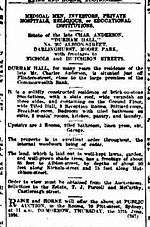Durham Hall, Surry Hills

Durham Hall is an historic house in Surry Hills, Sydney, New South Wales. It is a Colonial Georgian brick residence constructed in about 1835 for George Hill, a wealthy merchant.[1][2] The house has had many owners and has had varied uses including a club. Over the years it was subjected to very unsympathetic alterations and additions. By the 1950s the building was almost unrecognisable. However, in 1983 major renovations were done to the house and many of the unsuitable additions were removed. The property is now classified by the Heritage Council of New South Wales as a house of historical significance.[3]
George Hill and his family

George Hill was born in 1802 near Parramatta. He was the son of William Hill and Mary Johnson both of whom were convicts. His father obtained a pardon in 1813 and became a butcher. Hill also became a butcher and acquired considerable wealth by owning his own abattoir, purchasing several inns in Pitt Street and holding tracts of land.[4]
In 1832 he married Mary Ann Hunter who was the recently widowed wife of Alexander Hunter, a warehouse owner in Pitt Street.[5]
In 1835 Hill built Durham Hall on several lots of land that he had purchased. A few years after moving into Durham Hall his wife died aged 26 years.[6]
On 24 March 1841 he married Jane Binnie,[7] the daughter of Richard Binnie and Jane Studdart.[8] Over the years the couple had a very large family. Two of their daughters married into notable families of that time. The eldest daughter Mary Jane married Fitzwilliam Wentworth, the son of William Charles Wentworth in 1868. Another daughter Alice Helen married Sir William Charles Cooper, the eldest son of Sir Daniel Cooper.[9]
In 1842 Hill was elected to the Sydney Municipal Council and two years later became a magistrate. For a short time he was a Member of the New South Wales Legislative Council[2] and returned to municipal politics and in 1850 was elected Mayor of Sydney.[10][11]
Hill died in 1883 at age 81 after his buggy collided with a tram.[4] His wife Jane lived at Durham Hall for another six years and in 1889 rented the home to women who used it as a boarding house. Jane Hill died on 25 January 1896.[12][13]
Durham Hall as a boarding house

Durham Hall was used as a boarding house for ten years between 1889 and 1899. The first landlady was Mrs Cecilia Anderson who was there from 1889 until 1893. Shortly after she left Durham Hall there was a sensational Court Case which involved her and one of her boarders at Durham Hall.[14]
The next landlady was Mrs Mary Parker. She was the widow of Henry Parker who had died in 1993 in Queensland.[15] She advertised frequently in the Sydney Morning Herald for boarders and mentions that there was a tennis court.[16] One of her early advertisements is on the right.
In 1899, three years after Mrs Jane Hill's death in 1896, Durham Hall was sold. It was bought by Charles Anderson.
Charles and Mary Jane Anderson

Charles Anderson was born in Scotland in 1838. He came to Australia in about 1880. He and his wife Mary Jane had five children.
He established a large hat factory called Anderson and Co in Surry Hills. It was a five story building right behind Durham Hall in Nichols Street.[17] It has since been demolished and replaced by residential units.
Charles Anderson was also a director of City Mutual Life Assurance Society Ltd and was said to be a philanthropist and generous to many charities.

His wife Mary Jane died at Durham Hall in 1910.[18] Charles continued to live at Durham Hall until his death in 1924. The property was then sold. The advertisement for the sale describing the house in 1924 is on the left.
Durham Hall as a club
In 1924 Durham Hall became the German Concordia Club and over the next decade extensive unsympathetic alterations and additions were made. Some of these included a bowling alley and gymnasium. A new façade on the street frontage was also constructed.[19] The Concordia Club closed in 1939 and for the next few years the Master Bakers Association used it as an educational and social club.[20]
In 1943 the American Red Cross turned it into a club for U. S servicemen and added further major additions. This club closed after the War and in 1949 The Commonwealth Bank acquired the premises and made further alterations. In 1979 the National Trust classified the property and in 1982 a Permanent Conservation Order was placed on it.[19]
In 1983 major restoration of the building was made and unsympathetic additions were removed. Before this work was done the building was unrecognisable. A photo of it at this time was in the Sydney Morning Herald and a link to it on the internet is at this reference.[21]
Today the building is utilised by the Royal College of Pathologists of Australasia.[22]
References
- ↑ George Hill: Australian Dictionary of Biography – online edition
- 1 2 George Hill: List of former members of the New South Wales Parliament
- ↑ "Durham Hall". New South Wales Heritage Council.
- 1 2 Rutledge, Martha (1972). Hill, George (1802 - 1883). Australian Dictionary of Biography. Volume 4. Melbourne University Press. pp. 398–399.
- ↑ Sydney Morning Herald, 25 June 1832, p. 4.
- ↑ New South Wales Births Deaths and Marriages
- ↑ New South Wales, Births, Deaths and Marriages - 123,Vol 25C.
- ↑ Wentworth Family Tree
- ↑ New South Wales Births Deaths and Marriages.
- ↑ Mayors of Sydney
- ↑ Perdon, R., Sydney ’s Aldermen: a biographical register of Sydney City Aldermen 1842-1992, Sydney City Council, Sydney, 1995
- ↑ New South Wales Death Certificate - 1896/004756
- ↑ The Wentworth family tree.
- ↑ Morning Herald, 21 June 1894, p. 5.
- ↑ Brisbane Courier, 3 August 1993, p. 4.
- ↑ Sydney Morning Herald, 23 June 1894, p. 6.
- ↑ Sydney Morning Herald, 14 August 1912, p. 13.
- ↑ Sydney Morning Herald, 5 March 1910, pp. 14 and 28.
- 1 2 South Wales Heritage Council, “Durham Hall”
- ↑ Sydney Morning Herald, 3 January 1940, p. 13
- ↑ Morning Herald, 11 January 1981,
- ↑ Website of the Royal College of Pathologists of Australasia
Coordinates: 33°53′03″S 151°13′01″E / 33.8842°S 151.2169°E